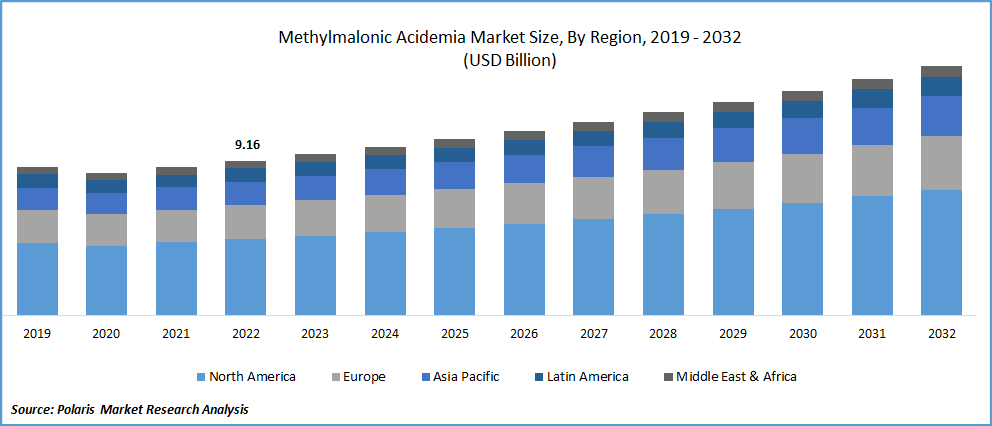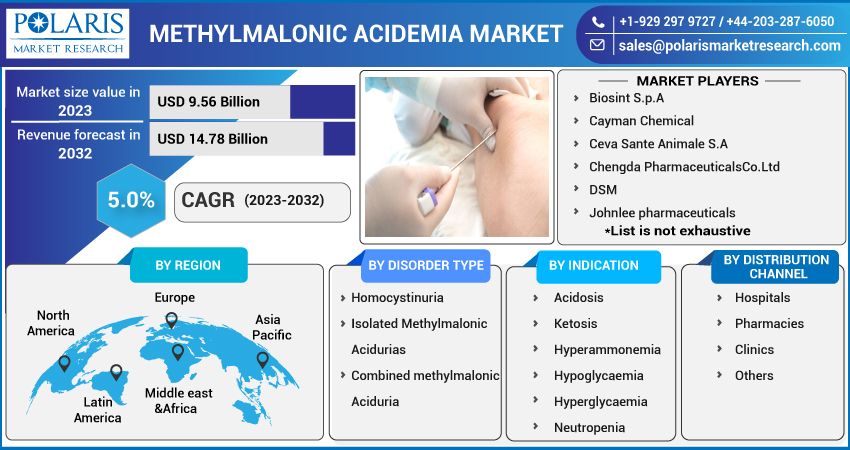
Methylmalonic Acidemia Market Share, Size, Trends, Industry Analysis Report
By Disorder (Homocystinuria, Isolated Methylmalonic Acidurias, Combined Methylmalonic Aciduria); By Indication; By Distribution Channel; By Region; Segment Forecast, 2023 - 2032
- Published Date:Mar-2023
- Pages: 115
- Format: PDF
- Report ID: PM3055
- Base Year: 2022
- Historical Data: 2019-2021
Report Outlook
The global methylmalonic acidemia market was valued at USD 9.16 billion in 2022 and is expected to grow at a CAGR of 5.0% during the forecast period. Methylmalonic acidemia (MMA) is a hereditary illness and a sort of "metabolic in-born mistake." Within this condition, an individual’s body is unable to adequately metabolize or break down specific proteins & fats (lipids) from the food ingested. The condition commonly emerges in early childhood and can range from mild to fatal. Mutations in the MMUT, MMAA, MMAB, MMADHC, & MCEE genes cause the condition.

Know more about this report: Request for sample pages
The biochemical property of MMA is the accumulation of methylmalonic acid in all bodily fluids and tissues. If a metabolic crisis is not handled, the patient may experience breathing difficulties, seizures, a stroke, coma, and even death. Methylmalonic acidemia is a condition in which the body is unable to break down specific proteins and lipids. As a result, a chemical called methylmalonic acid accumulates in the blood, and the illness is passed down through generations. A rise in illness prevalence throughout the world will boost methylmalonic acidemia market growth, as will a rise in healthcare affordability in the US, an increase in education and awareness among people, and increase in an unhealthy lifestyle, among other aspects driving the market growth.
Methylmalonic acidemia (MMA) is a set of genetically heterogeneous illnesses characterized by poor metabolism of certain amino acids (threonine, methionine, isoleucine, or valine), odd-chain fatty acids, or cholesterol esters. The biochemical definition of MMA is the buildup of methylmalonic acid in all bodily fluids and tissues. The majority of MMA patients show clinical signs and symptoms within the first few days or weeks of birth. The overall prognosis is poor, with occasional life-threatening acute metabolic decompensations caused by catabolic variables and major long-term consequences such as neurologic and renal impairment.
In Western populations, the incidence of MMA ranges from 1:48,000 to 1:61,000 births and from 1:50,000 to 1:500,000 births for PA. The total incidence is estimated to be one in 50,000 for isolated MMA and one in 100,000 to one million for PA.
According to studies, the detection rate of MMA and isolated MMA in North America and Europe was less than 2 instances per 100,000 newborns. The MENA area had higher detection rates, ranging from 3.97 to 6.65 per 100,000 new-borns.

Know more about this report: Request for sample pages
Industry Dynamics
Growth Drivers
When protein is digested in the human body, a molecule called methylmalonic acid is produced. The quantity of vitamin B12 in the body governs the formation of methylmalonic acid. A high level of methylmalonic acid might suggest a vitamin B12 deficiency. A low methylmalonic acid level may suggest an infection, liver disease, or other problem. The methylmalonic acid test can detect vitamin B12 deficiency, anemia, infection, liver disease, and other illnesses. The increasing frequency of anemia and vitamin B12 deficiency are major reasons driving global demand for methylmalonic acid.
The market is growing due to an increase in understanding and awareness of methylmalonic acidemia. People's poor lifestyles contribute to an increase in cases of methylmalonic acidemia, which enhances the global market for MMA. Increased R&D initiatives to bring about medical modernization and technology improvements pave the way for additional prospects in the methylmalonic acidemia market in the future.
Report Segmentation
The market is primarily segmented based on Disorder Type, Indication, Distribution Channel, and Region.
|
By Disorder Type |
By Indication |
By Distribution Channel |
By Region |
Acidurias
|
|
|
|
Know more about this report: Request for sample pages
Isolated Methylmalonic acidurias disorder type is accounted for the largest market share in 2022
Methylmalonic aciduria with homocystinuria is a hereditary condition in which the body is unable to effectively digest amino acids, lipids, & cholesterol from the diet. This illness combines symptoms from two different conditions: methylmalonic acidemia and homocystinuria. Babies that develop the illness early in infancy have trouble gaining weight (failure to thrive), feeding issues, and a pale complexion. Babies may also experience convulsions and have low muscle tone (hypotonia). Most newborns and children with this illness have a tiny head (microcephaly), intellectual impairment, and developmental delay. Genetic alterations in one of many genes can induce methylmalonic acidemia with homocystinuria: HCFC1, MMADHC, ABCD4, LMBRD1 or MMACHC. Genetic mutations in five genes, cblC, cblD, cblJ, & cblX, are responsible for many kinds of illness.
Pathogenic mutations in the concerned gene for methyl-malonyl-CoA mutase or in the genes for enzymes involved in the intracellular metabolism of the cobalamin can induce the isolated methyl-malonic aciduria. Few of these mutations might be cobalamin sensitive. The kind of methylmalonic aciduria cannot always be presumed based on clinical presentation, and the response to cobalamin must be examined in order to administer suitable cobalamin or prevent needless therapy.
CMAMMA (combined malonic & methyl-malonic aciduria) is a disorder in which the body has excessive amounts of specific substances known as malonic acid & methyl-malonic acid. Although both amounts of methyl-malonic acid in urine are raised, this disease is distinguished by larger levels of methylmalonic acid. CMAMMA symptoms might appear as early as childhood. The accumulation of acids in certain youngsters leads the blood ketoacidosis, which can harm the body's tissues & organs. Symptoms include dystonia, hypotonia, developmental delay, failure to thrive, hypoglycemia, & coma.
Hyperammonemia is expected to grow significantly over the projected timeline
Hyperammonemia is a metabolic disorder characterized by elevated ammonia levels, a nitrogen-containing molecule. Ammonia is a very toxic neurotoxin. Hyperammonemia is most typically characterized by neurological signs and symptoms, which can be transient or chronic, depending on the underlying abnormalities. Hyperammonemia should be detected early and treated promptly to avoid the development of potentially fatal consequences such as cerebral edema and brain herniation.
Hyperglycemia is a condition when the sugar levels in the blood go high abnormally. This occurs when your body has insufficient insulin or when your body is unable to utilize insulin correctly, as in type 2 diabetes. Hypoglycemia is a condition when the sugar levels in blood go low as body produces insulin in high levels, resulting in low blood sugar levels. It is frequent in patients with type 1 diabetes and can happen to those with type 2 diabetes who are taking insulin or certain medicines.
Hospital Distribution Channel held the largest market share over the forecast period.
In 2022, hospitals estimated for the largest profit share. The market for hospitals is anticipated to grow significantly over the coming many times as a result of expanding public-private hookups, rapid-fire advancement in healthcare structure, and better access to healthcare services. The retail pharmacy segment had the largest market share and is predicted to maintain its supremacy throughout the forecast period.
The growing popularity of eCommerce channels for prescription medications is a key factor in the online distribution segment's profitability over the forecast period. Online pharmacies offer a wide range of treatment options for this disease, as well as in-depth information about the condition. Consumers who have this information are more likely to buy medicines online.
North America dominates the market share in 2022
North America has a major market share due to continuous lifestyle changes, increased healthcare expenditure, increased availability of funds for research, a large patient population, and increased government support for R&D in this region.
Because of rising health consciousness among consumers, the Asia-Pacific region is expected to hold a significant share of the methylmalonic acid market. Individuals' preference for regular health checkups and blood tests is now becoming a common lifestyle. As a result of this growing trend, many pharmaceutical companies have begun redefining test kits and medicines and selling them through both online and offline channels. Furthermore, people in these regions are becoming more aware of the importance of early disease detection, which is fueling growth in the global market.
Competitive Insight
Some of the major players operating in the global market include Biosint, Cayman Chemical, Ceva Sante Animale, Chengda Pharmaceuticals, John lee pharmaceuticals, Merck, Sanofi, Tokyo Chemical Industry, and Lonza group.
Recent Development
- In April 2020, Logic Bio Therapeutics received FDA approval for LB-001, a drug to cure the extreme conditions of methylmalonic acidemia.
- In 2021, Recordati Rare Diseases got FDA approval for CARBGLU tablets 200 mg to treat acute hyperammonemia.
- In 2020, Moderna introduced mRNA-3704 to treat patients with isolated methylmalonic acidemia.
Methylmalonic Acidemia Market Report Scope
|
Report Attributes |
Details |
|
Market size value in 2023 |
USD 9.56 billion |
|
Revenue forecast in 2032 |
USD 14.78 billion |
|
CAGR |
5.0% from 2023 - 2032 |
|
Base year |
2022 |
|
Historical data |
2019 – 2021 |
|
Forecast period |
2023 - 2032 |
|
Quantitative units |
Revenue in USD billion and CAGR from 2023 to 2032 |
|
Segments Covered |
By Disorder Type, By Indication, By Distribution Channel, By Region |
|
Regional scope |
North America, Europe, Asia Pacific, Latin America; Middle East & Africa |
|
Key Companies |
Biosint S.p.A, Cayman Chemical, Ceva Sante Animale S.A, Chengda Pharmaceuticals Co.Ltd, DSM, Johnlee pharmaceuticals, Merck KGaA, Sanofi, Tokyo Chemical Industry Co.Ltd, Lonza group |
FAQ's
The methylmalonic acidemia market report covering key segments are disorder type, indication, distribution channel, and region.
Methylmalonic Acidemia Market Size Worth $14.78 Billion By 2032
The global methylmalonic acidemia market expected to grow at a CAGR of 5.0% during the forecast period.
North America is leading the global market.
Key driving factors in methylmalonic acidemia market are increase awareness of methylmalonic acidemia and rising R&D initiatives to bring about medical modernization.
